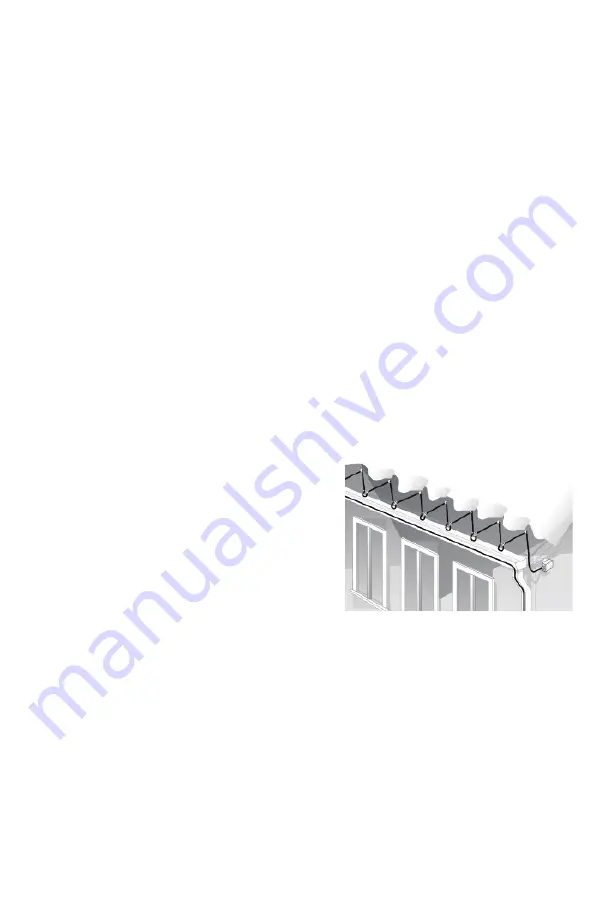
8
FINAL INSTALLATION STEP
Check to be sure that the cable has NOT been removed from its intended position.
The heated portion of the cable MUST be positioned entirely on the roof.
Place the labels for the Circuit Breaker / Fuse Panel near the appropriate circuit breaker / fuse so that they are
clearly visible to current and future users.
INSTALLATION INSTRUCTIONS FOR THE ROOF & GUTTER DE-ICING CABLE (cont’d)
Pattern for other special roof areas - Other problem roof areas not previously described may also be treated
with the de-icing cable to prevent ice dam formation. Triangles - similar to those used for the roof line can also
be used to treat these special areas. In treating these special problem areas, the height of the triangles may be
greater than those used at the roof edge. Keep the triangle based at 15 inches, but increase the triangle height
so it extends at least one shingle row (5½ inches) into the warm roof section.
ROUTING OF CABLES IN DOWNSPOUTS
“Along run” downspouts
- For downspouts that are along the run of the roof line being treated, the cable must
be routed down and back up the inside of the downspout. Do NOT wrap the cable around the downspout or
otherwise attempt to attach it to the outside.
Remember
: to avoid overheating the cable and increasing the
risk of fire or electric shock, no part of the downspout may pass through a building.
You must first determine the total length of cable needed to go down and back up the downspout.
It is important to measure as accurately as possible because the cable must be flush with the end of the
downspout. Several methods for determining the length may be used. One is to tie a small weight to a string
and lower it into the downspout. Once the string passes through the bottom of the downspout, mark the string
as needed to record the length of the downspout. You will need twice this length of cable.
Alternatively, you could also use a tape to measure each section of the downspout. To calculate the total cable
needed, add the measurements in each section and multiply by 2.
Lastly, if it is not possible to use either of these above methods, you may use the cable itself to estimate the
length of cable needed in the downspout. However, to avoid snagging or cutting the cable on sharp edges, take
care when pulling the cable into and removing it from the downspout.
Inspect the cable for damage and do NOT use a cable that has been damaged
.
“End of run” downspouts
- If a downspout exists at the end of the run of the roof line being treated, the cable
must be routed down the inside of the downspout. There is no need to route it back up.
Do NOT wrap the cable
around the downspout or attempt to attach it to the outside
.
Pull cable into downspouts using weighted string. Be sure the
run of the cable is flush with the end of the downspout and that
no cable is extended out at the end of the downspout.
NO part of the downspout may pass through a building
.
If at this point you find that you have an excess of cable,
you may route the cable back up the downspout to take up
this excess. Alternatively, triangles on the roof can be made
larger (up to 5 feet in length) or cable loops in valleys can be
extended. If needed, NAMSR cable can be terminated on-site
where desired, using the NAM-END-KIT. If you have a shortage
of cable (the end of the cable does NOT reach to the bottom of the downspout), you may to reduce the height
of the triangles on areas of the roof that are less susceptible to ice dams.
When transferring from gutter to downspout, in-line or at end-of-run, always use a WARMUP Downspout
Hanger clip to prevent the cable from chafing against the sharp sheet metal edges of the gutter. Refer to the
specific instructions to apply such clip.
The above instructions assume ‘residential’ type gutters and spouts between 4” and 6” wide. For roof draining
larger applications that may require above normal melting. Consider double or triple cable runs. Though cables
should be kept spaced apart to ensure efficiency.











